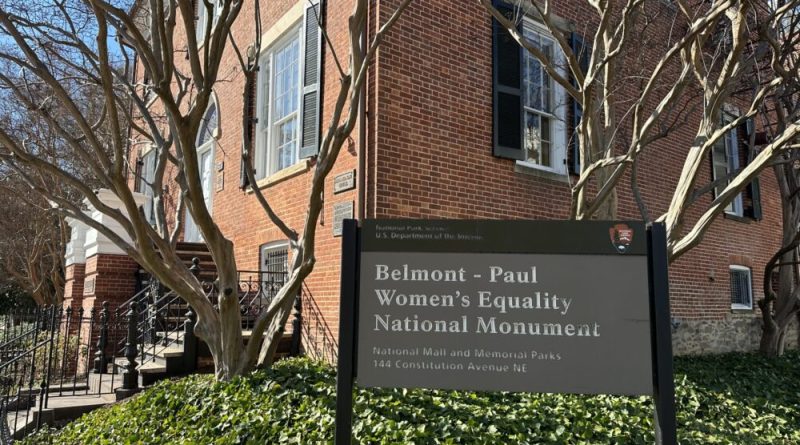Advocates keep pushing for the Equal Rights Amendment
WASHINGTON – Employees inside the former home of the National Women’s Party, now the Belmont-Paul Women’s Equality Monument, switched from activists to National Park Service rangers in 2016.
Crowds pass through every day, learning about the triumphs and failures of the party that moved into the home in 1929.
But the rights symbolized by the monument are still in limbo just down the street in the United States Capitol.
Despite more than a century-long push, the fate of the Equal Rights Amendment still sits in the hands of a deeply divided Congress, as well as various state legislatures, while debate continues over a controversial ratification deadline.
Origins of the ERA
In the 1920s, fresh off the success of the 19th Amendment that gave women the right to vote, National Women’s Party members began to look at how to stop other methods of sex-based discrimination in the United States.
Alice Paul, a member of the party, wrote the original Equal Rights Amendment in 1923. For nearly half a century, a version of the amendment was introduced in every session of Congress.
“Equality of rights under the law shall not be denied or abridged by the United States or by any state on account of sex,” the current version of the amendment, rewritten in 1943, states.
Congress passed the Equal Rights Amendment and sent it to the states for ratification in 1972, with a seven-year ratification deadline. Activists and Paul herself later cited that deadline as the reason for the amendment’s travails, arguing that the deadline would encourage states to delay their ratification.
“(Opponents) thought the only way they could defeat it now was not by an outright vote against but by making difficulties in ratification,” Paul said in an oral history with Amelia Fry, an historian at the University of California, Berkeley.
Paul continued to advocate for the ERA until a stroke three years before her 1977 death, according to The New York Times.
There have been opponents of the amendment since its inception, one of its most famous being the late anti-feminist attorney Phyllis Schlafly, who said the amendment would take away policies that benefit women, would institute a draft for women, enshrine same-sex marriage rights and protect the right to abortion in the Constitution.
Since the expiration of the 1982 deadline, three states – Nevada, Illinois and Virginia – have ratified the ERA. Virginia, the last state needed, ratified the amendment in 2020.
Recent push in Congress
With the threshold now met, politicians and advocates are rallying around the amendment once again - hoping to finally add the ERA to the Constitution.
Multiple members of Congress introduced legislation to move the amendment forward in 2023, for the 100th anniversary of the amendment’s first introduction.
The legislation follows two strategies: removing the 1982 deadline and then directing the archivist of the United States to add the amendment to the Constitution.
Rep. Ayanna Pressley, D–Massachusetts, said the House Equal Rights Amendment Caucus is leveraging every tool available to pass the legislation. Pressley founded the caucus in 2023 with Rep. Cory Bush, D-Missouri.
“The ratification threshold has been met,” Pressley said during a March 18 press conference. “The women of this country have done their job, states have done their job and now Congress must do its (job).”
Bush and Sen. Kirsten Gillibrand, D–New York, both introduced resolutions that would recognize the ERA as ratified and enforceable. Both bills are sitting in each chamber’s judiciary committees.
Sen. Ben Cardin, D–Maryland, also introduced now-failed legislation to remove the deadline in 2023 in the Senate. In 2012, he argued against the deadline because such a restriction isn’t included in the Constitution and another amendment, the 27th Amendment, took over two centuries to ratify.
“The women of this country are exhausted and it’s been 101 years too long,” Pressley said.
Some states take initiative
As activists wait on updates to the constitutional amendment, state-level Equal Rights Amendments have been passed.
As of 2022, 22 states have state-level Equal Rights Amendments and 28 states have forms of gender equality provisions in their constitutions, according to the Brennan Center for Justice.
Molly Gonzales, the advocacy manager at the Alice Paul Institute, said the state amendments give advocates a window into what the Equal Rights Amendment could do nationwide.
For example, the Pennsylvania Supreme Court used the state’s ERA in January to argue that abortion restrictions can be challenged as sex discrimination.
“We're kind of just starting to see the untapped potential of what that means,” Gonzales said about the state amendments.
Outside of Equal Rights Amendments, women’s rights advocates are pushing for legislation that would make specific forms of sex-based discrimination more strictly prohibited.
One such measure is the Paycheck Fairness Act – aimed at bringing more transparency and strengthening penalties regarding sex-based pay gaps – introduced by Rep. Rosa DeLauro, D–Connecticut.
“Our Paycheck Fairness Act would go a long way in terms of dealing with an Equal Rights Amendment,” DeLauro said in a March 12 press conference. “That would give strength to women's economic security.”
Why the ERA
Nearly 80% of Americans at least somewhat favor adding the Equal Rights Amendment to the Constitution, according to a 2020 Pew Research survey.
If there was an Equal Rights Amendment, Alice Paul Institute Executive Director Rachael Glashan Rupisan said, policies like recent abortion bans wouldn’t have happened.
“We just saw specific acts and bills that have been in place in the law of land for decades taken away very easily,” Rupisan said in an interview with Capital News Service. “That's the difference: It's a lot harder to take away a constitutional amendment.”
Since the ERA passed Congress in 1972, the gender pay gap has gradually decreased, but remains. In 1972, according to a report by the Congressional Research Service, women on average made almost 58% of men’s annual earnings. In 2022, women made 84% of men’s annual earnings.
Also important, Gonzales said, is that the ERA would explicitly place sex-based discrimination protections for women into the Constitution.
ERA advocates point out that the only place where women are mentioned in the Constitution is in the 19th Amendment.
“So women can vote but they can't really have anything else,” Gonzalez said. “The ERA is such an important issue, so many different generations and cross sections of people can really get behind it because we all have something to gain from it.”
The Belmont-Paul House
The National Women's Party became an educational nonprofit in 1997 and fully disbanded in 2020, after four years of sharing the house with the National Park Service.
In the Belmont-Paul House, National Park Service Ranger Susan Philpott and her co-workers share the legacy of Paul and other women’s rights activists with visitors from around the world.
Sitting inside the nation’s first feminist library, a converted carriage house inside the historic building, Philpott reflected on her time at the house.
One item in the house that resonates with Philpott every time she sees it is a chair formerly owned by Elizabeth Cady Stanton, a leader of the women’s rights movement in the mid- and late 19th century. The chair is extra long and oddly shaped to accommodate the big skirts worn by women at the time.
Philpott takes inspiration from this chair because at a time when even furniture was gendered, Stanton and the many women who worked inside this house had the audacity to imagine that women could be treated equally.
“I want people to know how hard change is,” Philpott said. “Sometimes the people who start the work don't get to see it to the end.”

Capital News Service is a student-powered news organization run by the University of Maryland Philip Merrill College of Journalism. With bureaus in Annapolis and Washington run by professional journalists with decades of experience, they deliver news in multiple formats via partner news organizations and a destination Website.

